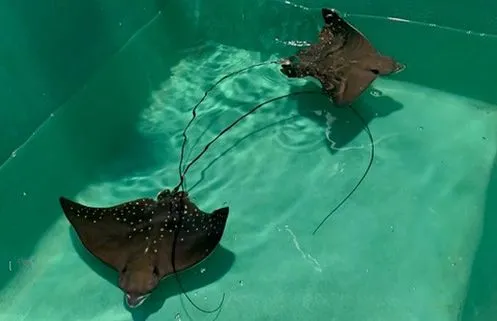Two little eagle rays Aetobatus ocellatus were born at Nausicaá on the 10th of August 2022. The day before, the aquarists in charge of the large tank had isolated the pregnant ray in the auxiliary tank to allow it to complete its gestation period in complete peace and calm.
Births of eagle rays at Nausicaá
A first for the centre in 2022!

Two fine babies!
The babies did not take long to appear, as the next morning, the keepers discovered the two babies. Two fine babies, as at birth, one ray had a wingspan of 45 cm and weighed 1.73 kg and the other had a wingspan of 47 cm and weighed 1.99 kg.
The gestation period for eagle rays lasts around 12 months and is aplacental viviparous, meaning that the eggs develop and hatch in the female's abdomen, giving birth to fully formed offspring.
The two male eagle rays have been moved to the aquariological reserves so that the keepers can easily monitor their growth. As the weeks go by, the keepers will teach the rays to come and fetch their food, a way for the keepers to monitor the quantity of food distributed and observe the animal's state of health.
A vulnerable species on the IUCN red list
In a few months' time, the eagle rays will be moved to a partner institution. In fact, eagle rays, classified as a vulnerable species on the IUCN red list, are part of a European conservation programme called EEP - Eaza Ex-situ programme. Nausicaá is involved in this programme.
Preserving the species entails transferring the young to the programme's partner structures in order to guarantee a genetically and demographically healthy population.
In the wild, the eagle ray is fished for its meat, cartilage and dorsal skin in South-East Asia, and the low fecundity of this species - 1 to 4 young every 2 to 3 years - also has a negative impact on its survival.
A steady stream of births at Nausicaá
These two males were the first to be born at Nausicaá since the eagle rays arrived in 2018. However, the centre has witnessed a number of ray births: small freshwater ocellate river stingrays, also known as black river stingrays, have joined the In the Eye of the Climate exhibition, little blackchin guitarfish are also regularly born at Nausicaá, as well as thornback skates.
There are births all year round at Nausicaá: leopard sharks, zebra sharks, shrimps, seahorses, clown fish, geckos, epaulette sharks and penguins!
The conservation programmes at Nausicaá
Nausicaá is a unique biodiversity conservatory where several hundred offspring are born every year. Furthermore, Nausicaá participates in European conservation programmes to save endangered species.